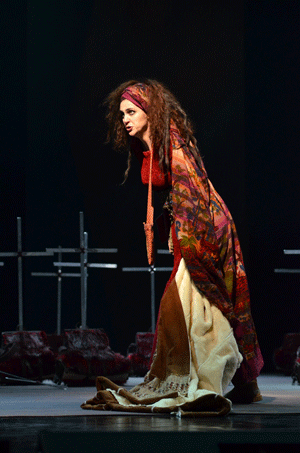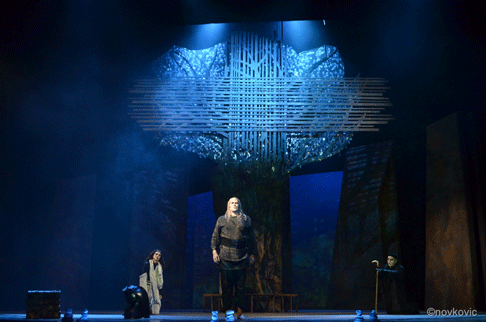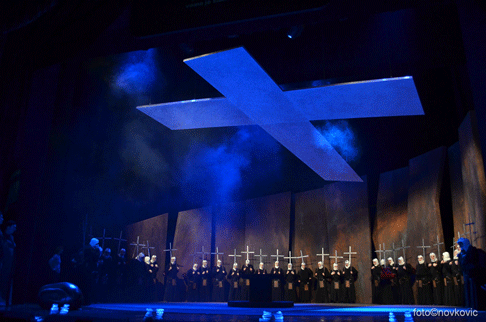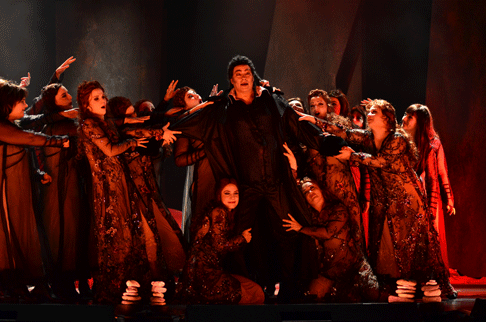26 Apr 2012
Zagreb’s Wagner Casts Its Spell
Croatian National Opera, in collaboration with Würzburg’s (Germany) Mainfranken Theater has made quite a forceful case for Parsifal.

Croatian National Opera, in collaboration with Würzburg’s (Germany) Mainfranken Theater has made quite a forceful case for Parsifal.
They have accomplished this first and foremost by assembling a cast of superlative singers, with pride of place going to the intriguing Kundry as impersonated by Dubravka Šeparović Mušović. She is an artist of great imagination and infinite variety. In Act One, she is a displaced street person, in Two a glamorous seductress who seems on the verge of a nervous breakdown as she vacillates between being Klingsor’s willing accomplice and a penitent in search of redemption. Free-wheeling moments of unbridled lust give way to nervous, guilty tics and stomach-churning disgust (for the character, not us). This was a valid, fully engaged, undeniably schizophrenic take on the character and Ms. Mušović wholly owned it.
 Dubravka Šeparović Mušović as Kundry
Dubravka Šeparović Mušović as Kundry
Nor did she stint in the vocal arena as she let loose with an awesome arsenal of well-calculated effects including a smoldering low voice, searing top, well knit registers, tenderly caressed phrasings, and superbly controlled dynamics, remarkably all of a piece. There was not a moment that she was not invested in the emotional truth of Kundry’s musical lines as she fully immersed herself in a highly personal traversal of one of opera’s most complex characters.
Anton Keremidchiev served up a commanding Klinsgor possessed of what was easily the most beautiful voice I have ever heard cast in this part. Instead of the usual muscled up ranting and bluster, here was a clean, penetrating instrument deployed with a commendable sense of line and dramatic purpose. No parking, no barking, just forcefully beautiful vocalizing.
Veteran Claudius Muth showed off an orotund bass as Gurnemanz, utilized with a keen understanding of his well-schooled technique. The low and middle range rolled out with an easy presence, and while the very highest notes are just outside his core comfort zone, Mr. Muth managed them with consummate skill. Davor Radić contributed a ringing, secure account of Amfortas. Perhaps a tad too secure since his solid, pointed baritone rarely dipped in volume much below forte. A bit of modulation and color would enhance his somewhat stentorian presentation of the suffering soul.
Ivica Trubić likewise intoned a solid, off-stage Titurel, although it was a bit hard to judge any nuance in his vocals since they were amplified with a good deal of reverb. The excellent Flower Maidens were the best matched, most vibrant, and thrillingly sung of any in my experience.
 John Charles Pierce as Parsifal, Dubravka Šeparović Mušović as Kundry and Manfred Hemm as Gurnemanz
John Charles Pierce as Parsifal, Dubravka Šeparović Mušović as Kundry and Manfred Hemm as Gurnemanz
That leaves our hero, and John Charles Pierce did not disappoint in the title role. I admit it, I am spoiled. My first Parsifal ever was Jon Vickers, who probably wrecked me for others forever. Mr. Pierce brought complete understanding to bear, and has a pleasant stage manner and a far more than serviceable tenor. Although he seems to cover the sound a bit, when he goes to nail a high phrase, he is able to summon a laser-like clarity. He was never less than thoroughly competent, and often brought joy, but he never quite elevated the role enough to make me forget that his is arguably the least interesting role in the opera.
Conductor Saša Britvić worked musical wonders in the pit helming this musical monster-piece. Predictably, the orchestra fared at its most virtuosic best in the more fiery Act Two, which bubbles and churns along more vividly. In the cruelly demanding expanses of One and Three, the group strove to much good effect in knitting the long, drawn out amblings into a unified whole. There were a few lapses of rhythmic impulse as the piece languidly unfolds (especially in the long rests which sapped the forward motion) and there was a slight dip in accurate intonation ‘round about the 100th minute of Act One, but overall, Maestro Britvić and his players should be duly proud of their achievement. The chorus, too, was trained to a fare-thee-well, and frequently raised goose bumps with their dynamic, poised singing.
To say the production recalls the best of the 1950’s is not to denigrate it in any way. In a nod to Wieland, designer Rudolf Rischer’s basic concept is a circle of Stonehenge-like monoliths that not only revolve at times to interesting new configurations, but also accept all manner of meaningful lighting gobo projections, such as stars, waves, etc. Within this milieu, the addition of a huge, tilted white cross, or the addition of a bridge skirted by red drapes provide all that is needed to adequately communicate Wagner’s intentions.
Gera Graf’s well-considered costumes are also rather timeless, offering a decidedly contemporary twist on the period. Flower maidens burst through the slit red drapes first demurely clad in white nun garb, with the wimples but minus the veils, then change and reappear in glittery, sequined, flesh-colored gowns. The knights are in generic tunics and cowls emblazoned with crosses, each with a sort of red-velvet back-pack that has a metal cross stuck upright in it. These get removed and positioned inventively about the stage, and the crosses later get extracted, upended, and brandished as swords.
 Scene from Parsifal
Scene from Parsifal
Parsifal is all ‘Heroic Montsalvat Man-in-Black’ and sports a wondrous wig of dreadlocks. Indeed all of the hair treatment was quite inspired, and the make-up plot was of the kind you never see anymore, meant to convey features all the way to the top row of the balcony. Kundry’s genial hippie bag lady attire of One yielded to the second act's generic black gown as she was first unfurled, moaning and blindfolded, out of a cocoon of a red carpet. Soon enough, she was got up in a form-fitting black number with an extravagant blond wig, the whole effect topped with a massive “dust cover” of white chiffon. This piece of cloth gets put to creative dramatic use and gets re-purposed any number of times, not least of which as an ersatz spider web.
Roger Vanoni’s lighting design was effectively varied and gloriously colorful. Best of all, the singers faces were (almost) always fully lit. How cool is that? (Or ‘hot’?) A single caveat is that one of the follow-spot operators needs a brush-up in technique. Either Parsifal was being too spontaneous in his Act Two peregrinations or the operator was inattentive or both, for the light was too often playing catch-up to the actor. The concept that Klingsor was clad in a red suit (a la the Devil in Jerry Springer — The Opera) and operated Vari-lights from a sort of DJ desk on the suspended bridge was a fun conceit. When 'Special K' commanded a disco display of flashing lights, it somehow made sense and underscored his control freak persona.
Director Kurt Josef Schildknecht has invested good intentions in his stage pictures and has created plausible relationships between his characters. There is sometimes a tendency to sing forward for implausibly long stretches, but then the plus side is that the balance between stage and pit was excellent. The seduction in Two was played out on a raised circle (Wieland again!) that was at once bed and altar. I quite liked the many ways the actors found to meaningfully place themselves on it, around it, away from it, and under it, all the while communicating volumes with their relative stage positions.
 John Charles Pierce as Parsifal with Blumenmädchen
John Charles Pierce as Parsifal with Blumenmädchen
Did everything work? Well, no. Klingsor’s hurling of the spear was ineffectual with two extras simply carrying it aloft to Parsifal who has absolutely no challenge to feebly raise his hand and grab it. However, I did like that he then used it and his sword to create a “cross,” the sight of which brought Klingsor to his knees like Dracula in submissive revulsion. The contemporary hospital bed for Amfortas remained a distraction for me throughout. And his hobbling around with crutches was dishonest since the actor could not remotely suggest that the character could not walk unassisted. Too, there was one unintentionally humorous moment, when a “page” was required to strike a three foot tall stack of ‘heavy’ over-sized books by just lifting them up and off like the Styrofoam they were!
Still, there are so many riches that were so successfully mined here from the challenging, enigmatic masterpiece that is Parsifal, that Croatian National Opera is to be (and was) loudly cheered for having brought such a thoughtful and committed performance to life.
James Sohre